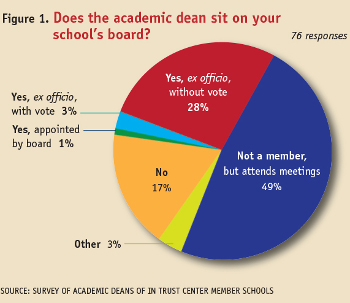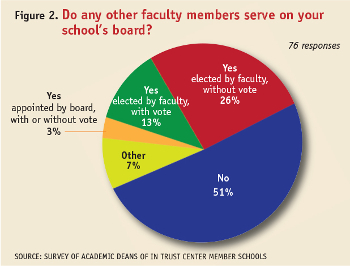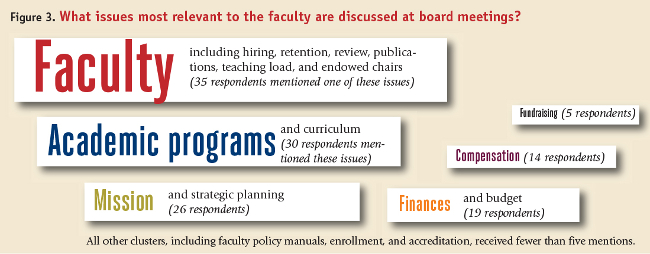"Shared governance” is often misunderstood. In higher education, it usually means that the governing board, the president (and the president’s senior administrative team), and the faculty have distinct roles in the leadership of the institution. For example, in many schools it’s the responsibility of the faculty to establish goals for teaching and learning (and assess how well those goals are achieved) and to set standards for faculty promotions and tenure.
Does “shared governance” imply that faculty members have representation on the governing board itself? Not necessarily. In many institutions, one or two faculty members are elected to represent their peers on the governing board, but at others, the responsibility for keeping the board apprised of educational issues falls to the academic dean, who may (or may not) serve as a member ex officio of the board.
This fall, In Trust asked 139 academic deans about their own role on the board, and the role of faculty representatives. Seventy-six deans completed the survey—a return rate of 55 percent.
Does the academic dean sit on the board?
As Figure 1 shows, almost half of the 76 respondents said that the dean attends board meetings without actually being a member of the board, while 28 percent said that the dean is an ex officio member of the board without vote. In the open-ended comment section of the survey, many of the deans who responded said that they “represent” the faculty in some fashion. “As dean, both I and the rector represent faculty concerns to the board,” wrote one. Another dean stated, “Faculty proposals go to the board via the deans.” A third dean wrote, “The president and the dean serve as conduits between the faculty and the board.”
 Among the subset of respondents from theological schools embedded in colleges and universities, the numbers were similar. Only 16 academic deans from these institutions responded to the In Trust survey, and among the 16, half said they attend board meetings as guests, a quarter said they attend as ex officio or appointed members, and another quarter do not attend board meetings at all.
Among the subset of respondents from theological schools embedded in colleges and universities, the numbers were similar. Only 16 academic deans from these institutions responded to the In Trust survey, and among the 16, half said they attend board meetings as guests, a quarter said they attend as ex officio or appointed members, and another quarter do not attend board meetings at all.
Do other faculty members sit on the board?
The responses from deans were divided fairly evenly, as Figure 2 shows. At about half of institutions, no faculty members sit on the board. (Institutions in which the president or another senior administrator sits on the board ex officio, but no other faculty sit on the board, were counted as having “no faculty” on the board.) But in almost half the schools, there is a faculty representative of some kind. In seven percent of schools, faculty members participate in board committees or attend some (but not all) board meetings as guests.
Once again, the deans in embedded schools told a similar story. Of those 16 deans who responded, half said they have no faculty representation on the board, a quarter said there is a faculty representative without a vote, 13 percent said they have a representative with a vote, and the rest have some other arrangement.
 Two of the deans who responded to the survey stated that faculty members do not want further representation on the board. “My profs do not want the vote, and they don’t want to attend the meetings,” said one. “Partially this is because they trust the board.”
Two of the deans who responded to the survey stated that faculty members do not want further representation on the board. “My profs do not want the vote, and they don’t want to attend the meetings,” said one. “Partially this is because they trust the board.”
Another said, “At my institution, the faculty does not do a good job of utilizing the ‘voice’ of the faculty representative.” This dean added that the faculty representative is empowered to report to the board’s academic and student affairs committees, but rarely does, and is empowered to report on the board’s activities to the faculty, but rarely does. “In other words,” the dean added, “the faculty could have more power on the board if they chose to access it.”
What issues most relevant to faculty are discussed at board meetings?
Seventy-one deans responded to this open-ended question. Because many submitted multiple issues, the total number of issues mentioned was 163, which we assembled into 26 clusters. The most-mentioned clusters of responses are shown in Figure 3.
Overall, the deans who responded to the survey show a fairly comprehensive understanding of the issues that boards face, and they largely see that these issues are relevant to the faculty. One caveat: Only a couple of deans mentioned accreditation, although accreditation standards clearly state that both the board and the faculty have roles in the accreditation process.

Formal structures of representation are important, and — spurred by accreditation requirements and financial crises — many institutions are working to improve their governance structures. In some cases, this means streamlining the board, making it smaller and more efficient, while modifying some of the more inclusive, representational models of the past.
But several of the deans who responded to the survey noted that formal structures depend a great deal on the individuals who occupy the organizational chart. “I think it depends on how well the president and academic dean represent the faculty,” wrote one dean. “Usually the need to have further representation stems from faculty frustration that they are not participating in decision making."
Another dean wrote, "I've seen many configurations and it seems to depend on people more than structure to work."
Deborah Gin, director of research and faculty development at the Association of Theological Schools, assisted with the interpretation of this data.